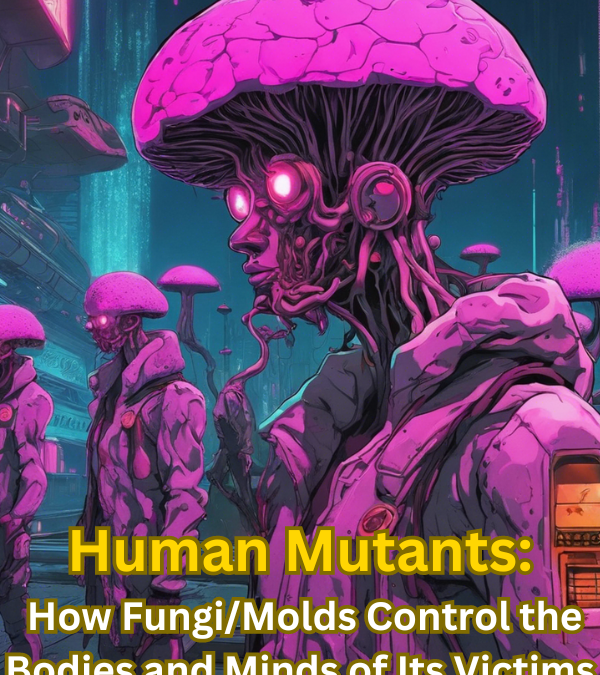
by Moe | Dec 13, 2023 | Demons, Duality, Mind Control Research, Toxic Mold
“This is one of the most complex examples of parasites controlling animal behavior because it is a microbe controlling an animal – the one without the brain controls the one with the brain.” – David Hughes Penn State University
Within the cosmic battleground of Earth, an eternal symphony and conflict persist, entangling the bodies, minds, and souls of all living entities within a web of inescapable interplay.
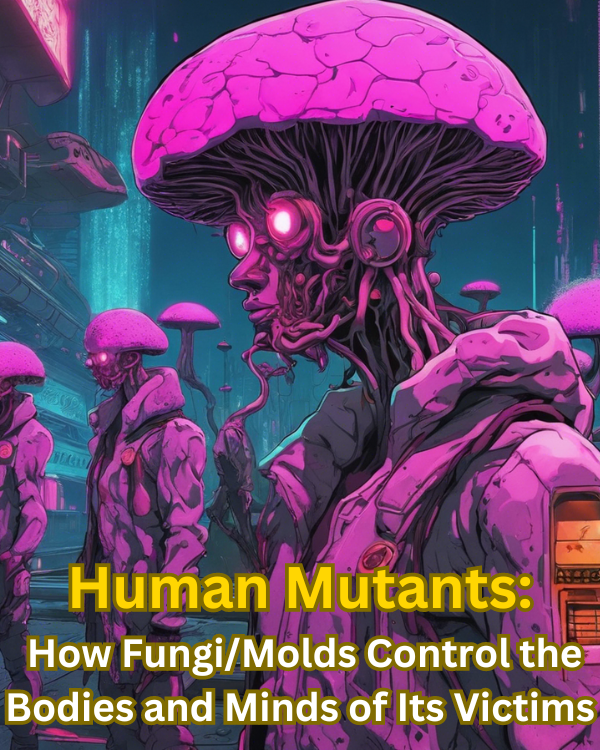
There is no refuge from the intricate melody of life and the dark filaments of warfare that bind us, compelled by the magnetic forces of nature to partake in an unending song or engage in mutual combat.
Nothing and no one is immune.
This eternal war we can observe all around us in those victims who have lost the fight as they begin to lose their bodies and control of their minds.
Zombie ants are a perfect example of one of nature’s bizarre phenomena who lost the battle I speak.
Studies have found that they are simply infected with a fungus that takes over their bodily processes, and DNA, and corrupts them to turn them into obedient, mind-controlled servants.
Researchers found that these ants were – 50% ant and 50% fungus.
Zombies, mutants, or hybrids…
As many of you know who follow my work, I believe the same process happens to humans.
QUICK FACT: Did you know that molds/fungi have been found in 100% of autopsied human brains of people who died from Alzheimer’s disease? (Perhaps they were also taken over and their memories wiped clean by the same foreign invaders who stole the ant’s brain.)
And NO Mr. David Icke, they are NOT reptilian elites so please go back to the research desk…
Back to the ants…
A recent study showed how scientists examined the activated genes in the heads of infected zombie ants firmly attached to plants, comparing them with the heads of uninfected ants.
Their findings revealed that when ants were affixed to leaves but still displaying signs of life, only about half of the cells in their heads belonged to the ants themselves; the remainder comprised cells of the invading fungal parasite. Their cells had been combined in the blood, brain, head muscles, and fatty tissue.
During this period of zombie ant behavior, the parasitic fungus triggered a unique set of genes influencing neurotransmitters akin to serotonin, noradrenaline, and dopamine which exhibited heightened activity while the host ants manifested their peculiar zombie-like conduct.
For example, depletion of serotonin in ants is known to hinder proper foraging, and in other animals, disruption of these neurotransmitters can induce hallucinations and muscle spasms. Serotonin is involved in numerous physiological processes in ants as it is in humans such as sensorimotor skills like sleep, memory, feeding, pain, motor activity, biological rhythms, and neural development.
In other words, the fungi put the ant into a sleep-like waking state as it manipulates the behaviors in its favor by influencing these neurotransmitter systems and specific chemical processes that allow it to take over the mind.
Again, I contend that the same thing happens in humans.
As you can see, serotonin regulates and controls many functions crucial to an ant and a human’s survival and as I mentioned, this is done by our microbiota via neurotransmission.
In 2020, a study found that human neurons are like “mini computers” communicating through a root-like structure inside our bodies called dendrites.
A dendrite means “a structure of nerve cells that comprise the human brain.” The word was coined by scientists who first studied the structure of the brain, they noted its strong resemblance to trees so they named it after the Greek Dendron, meaning “tree.”
These dendrites appear to be natures, animals, mammals, and humans’ super internet signaling pathways that we all share. A type of biological internet for communication and a whole host of other mechanisms such as parasitism and natural selection.
A textbook neuron resembles a leafless tree, with extensive roots, i.e., dendrites leading to a robust, bulbous base—the body.
Electrical signals, akin to water and nutrients, ascend through dendritic roots into the body, where a hump-like structure amalgamates all information. If the sound wave/electrical stimulation is strong enough, it travels down a solitary tree trunk—the output cable, or axon—before being relayed to another neuron via bubbles containing chemical messengers or electricity.
Studies have shown that human dendrites are electrically excitable, exhibiting backpropagating action potentials and fast dendritic calcium spikes.
Dendritic processes play a fundamental role in receiving information via transducing receptors (sensory neurons) or incoming synaptic contacts (conventional neurons). In the presence of weak input signals, the neuron discards the data. Neuroscientists commonly describe single neurons as “binary” or “digital,” reflecting their tendency to either fire or remain inactive.
Through the examination of individual neurons in rodent brains, scientists have recently uncovered that dendritic trees are not merely passive cables; instead, they are highly active components that play a crucial role in a concealed layer of neural computation. Some dendritic trees, for instance, can produce electrical spikes five times larger and more frequent than the conventional firing of neurons.
Rather than recording from a living, intact human brain, the research team decided to study fresh slices of the brain’s cortex removed from patients due to epilepsy or tumors. Utilizing brain tissue from two different patient groups helped them identify signals unique to each brain disease, allowing the researchers to unravel the fundamental computations of human dendrites.
A peculiar signal quickly manifested.
Human dendrites exhibited activity, but the electrical spikes rapidly diminished as they traveled toward the cell’s surface. In contrast, a typical neural signal maintains its intensity as it travels along the output cable to its next destination.
What’s even stranger is that dendritic signals relied exclusively on calcium ions to generate electricity, a significant departure from conventional neural signaling.
The researchers concluded;
“It’s like suddenly discovering a new species that consumes carbon dioxide, rather than oxygen, to sustain its activity—except that species is part of you. ”
This is EXACTLY what I believe is happening to humans.
This species they speak of I contend are fungi/molds that can control and kill their victims, whether it be an ant, pant, or human as they see fit based on these electrical and chemical signals I speak of such as the loss of serotonin.
This loss would create a specific sound wave frequency that the fungi would use for sensing purposes to repel or magnetize their victims like what I contend happens to people who contract Alzheimer’s disease (AD). A disease with currently 50 million victims
For example, new studies have suggested that serotonin loss in humans may be a key player in cognitive decline, rather than a side-effect of Alzheimer’s disease.
As it turns out, approximately 90% of the serotonin the human body produces by our microbiota is in the gastrointestinal tract, where it regulates several bodily functions via a serotonergic pathway. Studies have found that the serotonergic pathway is modulated by gut commensal microbiota components in our gastrointestinal (GI) tract where it manages and controls the gut-brain axis.
Meaning it is our microbiome (fungi) that manages and controls (immune system) our physical and mental health.
What scientists are finding is that the microbiome has signaling mechanisms within this axis that allow it to communicate with the gut and the brain. This is called a neurotransmitter and serotonin seems to be one of the the most important mediators in microbiota–host interactions.
The serotonergic system controls the GI tract and the central nervous system (CNS) physiology. When this pathway is disrupted or corrupted, the disruption results in a wide range of pathologies that are affected thus causing a wide range of brain and intestinal diseases.
The serotonergic pathway plays a crucial role in sensorimotor function, which combines two important components: sensory input and motor output.
Sensory input to visual stimuli involves the information received through our sensory systems, including vision, hearing, smell, taste, touch, and proprioception (the sense of body position and movement).
Motor output refers to the response generated by our body in reaction to the sensory information received. Sensorimotor skills are also influenced by individual experiences and learning.
Sensorimotor skills refer to the ability to receive sensory messages from the environment and our bodies, and then generate an appropriate motor response. These skills are crucial for our daily functioning and play a fundamental role in our overall development and interaction with the world around us.
It involves the coordination and execution of movements, whether they are fine motor skills (such as writing or buttoning a shirt) or gross motor skills (such as walking or throwing a ball). These movements are the result of complex interactions between our brain, muscles, and nervous system.
Each of these sensory systems provides us with essential information about our surrounding environment and our bodies.
Sensorimotor skills are acquired and developed through a process of continuous learning and refinement from infancy through adulthood. In infancy, sensorimotor skills are foundational for the development of other cognitive and physical abilities.
Babies learn to grasp objects, visually track moving stimuli, and explore their environment through touch and taste. As they grow, they gain more control over their movements and refine their sensorimotor skills to perform more complex tasks.
Through repetition and practice, individuals refine their abilities and become more efficient in performing specific tasks. This process is known as motor learning. For example, a novice pianist may initially struggle with finger dexterity and coordination but with practice, they become more proficient in playing complex pieces.
For example, our visual system allows us to see and process visual stimuli, such as colors, shapes, and movements. Our auditory system enables us to hear and interpret sounds, while our olfactory system helps us perceive different smells.
Similarly, our taste buds allow us to experience flavors, and our sense of touch allows us to feel textures, temperatures, and pressure. Proprioception, on the other hand, provides us with information about the position and movement of our limbs and bodies in space.
Studies have indicated a correlation between motor activity and serotonergic function, and the firing rates of serotonergic neurons responding to intense visual stimuli.
In addition to the natural progression of sensorimotor skills through typical development, some individuals may experience challenges or delays in the acquisition of these skills. Sensory processing disorders, for example, can affect how individuals perceive and respond to sensory information.
Animal models propose that kainate signaling negatively influences serotonin actions in the retina, potentially impacting the regulation of the visual system. The descending projections create an inhibitory pathway referred to as the “descending inhibitory pathway,” which may have implications for disorders such as fibromyalgia, migraine, and other pain disorders, as well as the efficacy of antidepressants in treating them.
A neuron that secretes 5-HT is termed as serotonergic. It is a very important neurotransmitter in the Central Nervous System but when it becomes impaired, or damaged, it decreases in this process causing sensory processing disorders. Hence, pathology ensues along with illness and disease.
5-HT in humans is extensively present in various bodily systems, such as the nervous, gastrointestinal, and cardiovascular systems. It influences a broad range of physiological and pathological conditions, including pain, sleep regulation, aggression, feeding, anxiety, and depression.
The disturbance of 5-HT signaling in various pain states has been observed in both basic research and clinical studies, suggesting a potential explanation for certain diffuse pain conditions. In certain neuropathic pain models, the baseline level of 5-HT in the spinal cord was found to be reduced.
Researchers have found that the disruption of 5-HT neurotransmission contributes to the decline in cognitive processes associated with aging, Alzheimer’s disease (AD), and various neuropathologies, including schizophrenia, stress, mood disorders, and depression. Also, people with autoimmune disorders like AIDS and similar diseases have significantly lower 5-HT and an increased rate of infections.
Multiple studies have affirmed the pathophysiological importance of the 5-HT system in AD, with several drugs enhancing 5-HT neurotransmission proving effective in addressing AD-related cognitive and behavioral deficits.
5-HT receptors, 5-hydroxytryptamine receptors, or serotonin receptors, are a group of G protein-coupled receptor and ligand-gated ion channels found in the central and peripheral nervous systems. They mediate both excitatory and inhibitory neurotransmission.
As I explained in my previous essay, recent studies suggest that vibrations caused by sound waves directly affect the ion channels in fungal cells, resulting in electrical activity. Other hypotheses propose that sound-induced electrical responses in fungi are linked to their role in communication, growth, or defense mechanisms.
As it relates to nature, scientists have identified that the main jobs of fungi are breaking down organic matter, and processing nutrients and chemicals in a commensal, symbiotic, or pathogenic relationship with its host. For fungi to thrive within a host, they must navigate a dynamic and often challenging environment, necessitating the capacity to perceive and understand their surroundings.
Under typical circumstances, predisposing host factors, like immune suppression, play a crucial role in the survival and propagation of pathogens within mammalian hosts. Once inside the host, these pathogens must contend with the host’s microbiota for essential nutrients. For opportunistic pathogens, breaches in the normal physiological barrier, whether in mammals or plants, serve as entry points.
Fungi have developed various virulence mechanisms to elude the host’s immune system, a topic thoroughly explored elsewhere (Collette and Lorenz, 2011). Sensing these external cues is necessary to adjust fungal morphology, metabolism, mating, and virulence. Furthermore, extensive reviews have delved into how fungi sense environmental cues such as nutrients, gasses, light, and stress (Bahn et al., 2007).
Fungal infections have become a significant medical challenge, and a team of researchers at Baylor College of Medicine has made a significant breakthrough in studying the short-term effects of fungal infection in the brain. According to a study published in the journal Nature Communications, the researchers discovered that Candida albicans, a common yeast and type of fungus, can cross the blood-brain barrier and trigger an inflammatory response in mice.
This response led to the formation of granuloma-type structures and temporary mild memory impairments in mice.
Researchers injected C. albicans into mice’s bloodstream and discovered that the yeast can cross the blood-brain barrier, triggering the activation of microglia cells in the brain. The microglia cells became highly active, consuming and digesting the yeast, while also producing molecules that caused an inflammatory response.
This led to the formation of a granule-type structure called fungus-induced glial granuloma (FIGG). The mice infected with the yeast showed impaired spatial memory, which improved once the infection cleared. Although the yeast infection cleared in about 10 days, the microglia cells remained active and the FIGGs persisted for at least 21 days.
These amyloid molecules are typically associated with Alzheimer’s disease.
“These findings suggest that the role fungi play in human illness potentially goes well beyond allergic airway disease or sepsis,” according to Dr. David B. Corry, professor of medicine-immunology, allergy and rheumatology and Fulbright Endowed Chair in Pathology at Baylor College of Medicine.
“The results prompted us to consider the possibility that in some cases, fungi also could be involved in the development of chronic neurodegenerative disorders, such as Alzheimer’s, Parkinson’s and multiple sclerosis. We are currently exploring this possibility,” Dr. Cory said.
Since they do not have eyes and a nose to successfully adapt, fungi must be attuned to external environmental and biochemical factors to process this information to respond and identify unique host-specific elements. They do this by sensing and reacting to the host’s temperature, pH, gasses, nutrients such as sugars, amino acids, nitrogen, and other trace elements along with serotonin, which are all essential for the growth and viability of fungal symbioses or pathogeneses in every environment.
Given that the fungal cell wall maintains constant contact with its surroundings, the expression of receptors, such as pheromone receptors, on the cell wall surface becomes crucial.
Pheromone receptors are proteins that are sensitive to pheromones, which are chemical signals that organisms release to communicate with each other. These signals play a crucial role in various biological processes, including mating, territory marking, and social organization. Pheromone receptors are found in a wide range of organisms, from bacteria and fungi to insects and mammals.
In 1961, researchers noted that some “chemical messengers” act within an individual (e.g., hormones and “other excitatory substances” such as CO2), whereas others (i.e., “pheromones”) act between individuals via ingestion, absorption, or sensory receptors. However, fast forward to 2023, various studies have not revealed conclusively if humans create pheromones on their own.
Considering the chance that we do not create them on our own, the question arises: where do they come from?”
Pheromones in humans may be present in bodily secretions such as urine, semen or vaginal secretions, breast milk, and potentially also saliva and breath, yet most attention thus far has been directed toward axillary sweat. However, studies suggest that we can detect each other through unique smells produced by signaler pheromones
In fungi, pheromone receptors are particularly important for sexual reproduction. They are eukaryotic organisms that reproduce both sexually and asexually.
During sexual reproduction, fungi use pheromones to signal their mating compatibility with other individuals of the same species.
This process is essential for the fusion of specialized sexual structures called gametangia, ultimately leading to the formation of new genetically diverse individuals.
Here is an image explaining this biological process:
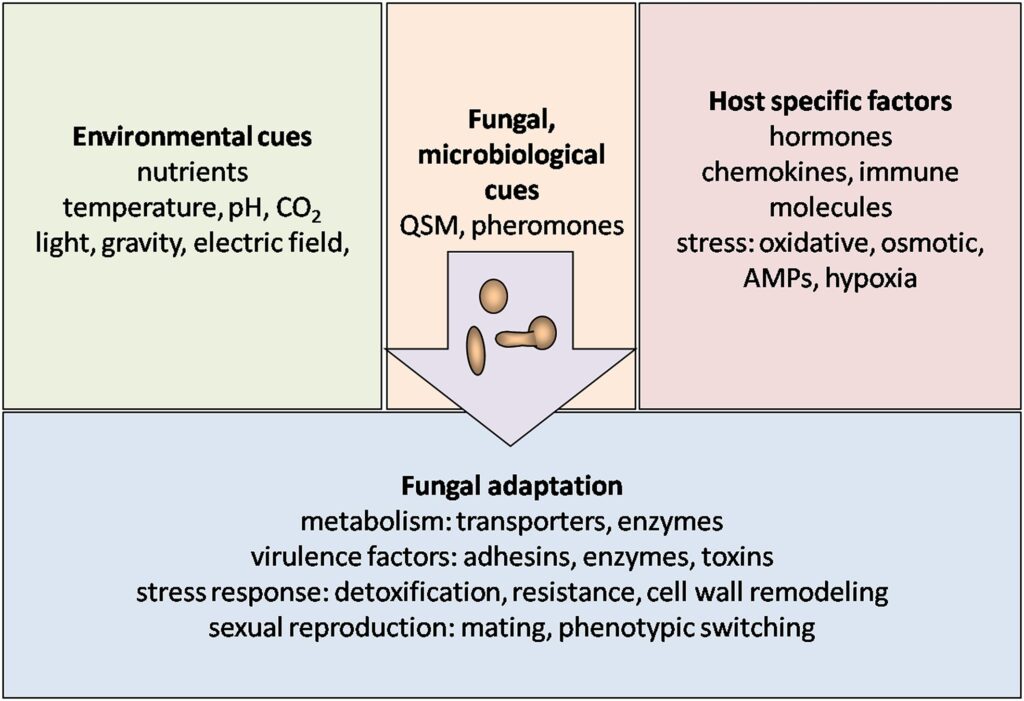
The typical lifecycle of fungi involves the following steps:
1. Pheromone production: Fungi release pheromones into their environment. These pheromones act as signaling molecules, indicating the presence and mating compatibility of the releasing individual
2. Pheromone reception: Potential mating partners have pheromone receptors on their cell surfaces. These receptors are specific to the type of pheromones produced by compatible mating partners.
3. Chemotropism: The receiving fungal cells respond to the pheromones by growing towards the source of the pheromone (a process known as chemotropism). This directional growth helps mating partners to come into proximity.
4. Cell fusion (plasmogamy): Once the compatible cells come into contact, they undergo cell fusion or plasmogamy. This fusion of cytoplasmic contents is a crucial step in sexual reproduction.
5. Formation of sexual structures: Following plasmogamy, specialized structures such as a zygote or a dikaryotic mycelium are formed, depending on the fungal species.
6. Completion of sexual reproduction: The sexual structures eventually lead to the formation of spores or other structures that can disperse and give rise to new individuals.
The entire process is tightly regulated by the interaction between pheromones and their corresponding receptors. The specificity of these interactions ensures that mating occurs only between compatible individuals of the same fungal species. The study of pheromone signaling in fungi has provided valuable insights into the molecular mechanisms underlying sexual reproduction in eukaryotic organisms.
These pheromone receptors not only facilitate chemotropism for mating but also serve other essential roles. These chemicals in the body are “electrically charged” — when they have an electrical charge, they are called ions. ‘
The term “ion” finds its origin in the Greek language, specifically derived from the neuter present participle of “ienai” (Greek: ἰέναι), which translates to “to go.” In the realm of ions, a cation is associated with downward movement (Greek: κάτω pronounced kato, meaning “down”), while an anion is linked to upward movement (Greek: ano ἄνω, meaning “up”).
It is this ion channel that I believe is the main method that fungi use to exploit and corrupt once the negative charge ions become too imbalanced
An ion, as introduced by English physicist and chemist Michael Faraday in 1834, is a term used to describe a species that travels from one electrode to another through an aqueous medium. This concept was developed after a suggestion by the English polymath William Whewell. To understand the concept of an ion, it is necessary to delve into the world of chemistry and electricity.
In the realm of electrochemistry, ions play a crucial role. An ion is an atom or a molecule that has gained or lost one or more electrons, resulting in a net positive or negative charge. These charged particles are formed when an atom gains or loses electrons to achieve a stable electronic configuration.
The operation of batteries also relies on ion migration.
In a typical battery, chemical reactions occur at the electrode surfaces, resulting in the generation of a voltage. This voltage drives the migration of ions between the electrodes, allowing for the transfer of charge and the production of electrical energy.
During discharge, positive ions move from the anode to the cathode, while negative ions move in the opposite direction. This ion migration enables the flow of electrons through an external circuit, producing an electric current.
The term “ion” was coined by Faraday to describe the movement of these charged species during electrolysis. Electrolysis is a process that utilizes an electric current to drive a non-spontaneous chemical reaction. It involves the decomposition of an electrolyte, a substance that conducts electricity when dissolved in a solvent, typically water.
During electrolysis, an external electric current is applied to an electrolytic cell, which consists of two electrodes, an anode (positive electrode) and a cathode (negative electrode), immersed in an electrolyte solution. When the electric current flows through the cell, ions are attracted to the respective electrodes based on their charge.
The movement of ions from one electrode to another through the aqueous medium is what Faraday referred to as an ion catation. The term “catation” is derived from the Greek word “kation,” meaning “to go down.” This reflects the movement of positively charged ions, known as cations, towards the cathode.
On the other hand, negatively charged ions, known as anions, migrate towards the anode during electrolysis. These anions are formed when an atom gains one or more electrons, resulting in a negatively charged species. The migration of anions is often referred to as anion catation.
Anion (−) and cation (+) indicate the net electric charge on an ion. An ion that has more electrons than protons, giving it a net negative charge, is named an anion, and a minus indication “Anion (−)” indicates the negative charge. With a cation it is just the opposite: it has fewer electrons than protons, giving it a net positive charge, hence the indication “Cation (+)”.
In addition to their roles in electrochemical processes, ions are also essential for maintaining the balance of charges in various biological systems. In living organisms, ions such as sodium (Na+), potassium (K+), calcium (Ca2+), and chloride (Cl-) play vital roles in nerve conduction, muscle contraction, and maintaining osmotic balance.
The movement of ions across cell membranes through specialized ion channels allows for the transmission of electrical signals and the regulation of cellular functions.
HOW FUNGI USE SOUND WAVES AND FREQUENCIES CONTROL THE WORLD
Studies have shown that fungi are extremely polarized organisms that constantly produce internal electrical currents and fields that are generated by hyphae. Its growth requires a constant supply of proteins and lipids to the hyphal tip.
Researchers have proven that the individual hyphae of the filamentous fungi constantly perform cellular “monologue” and cell-to-cell dialog using signal oscillations to acquire or magnetically attract the nutrients it requires to grow and thrive within the host.
For example, studies have found how psilocybin reduces low-frequency oscillatory power in users’ brains, increases overall firing rates, and desynchronizes local neural activity. It indicates experiences correlate with the lagged phase synchronization of delta oscillations. Schizophrenia, which mimics symptomatically the psychotic effects of psilocybin, is associated with diffuse delta rhythms.
These oscillations create electricity which is one of the key factors shaping their growth and development. The hyphae become polarized and entrained as the branching of mycelium is induced by electric field frequency, which it uses to communicate and transport the raw human materials within the blood and central nervous system.
The electrical current helps fungi with the translocation of resources it gathers within the host using magnets and hydraulic pressure.
Recent studies have explored the potential of utilizing frequency-specific sounds as a viable substitute for chemical fungicides in combatting plant diseases. The research findings indicated that high frequencies possess the ability to impede mycelium growth, akin to the impact of high-pitched noises causing deafness.
Further investigation revealed noticeable morphological changes in the mycelium, providing insights into the mechanism. This suggests that certain sound wave frequencies can induce stressful growth conditions, presenting a sustainable approach to combating pathogenic fungal pathogens.
As signaling and metabolism in organisms are controlled by a precise ionic gradient across membranes, the disruption of this gradient contributes to cell death. This is a common mechanism exploited by natural and artificial biocides, including the ion channels gramicidin and amphotericin (a fungicide).
What is interesting and helps prove my theory is that researchers have recently found that 5-HT is a strong inhibitor of fungal growth.
So, not only are ion channels used to treat people with antifungal medicines, but supplementing with 5-HT in the serotonergic pathways can stop fungi from growing in the body and brain. As I mentioned, the serotonergic pathway is modulated by the gut commensal where 5-HT is biosynthesized with L-tryptophan (Trp) derived from our diets.
As I mentioned, the loss of serotonin or 5-HT causes a condition known as sensory processing disorder (SPD), which interferes with the typical processing of sensory information (stimuli) in the brain. This involves the processing of what you see, hear, smell, taste, or touch.
SPD may impact all senses or just one, resulting in heightened sensitivity to stimuli compared to the general population. These disorders can result in hypersensitivity or hyposensitivity to certain sensory stimuli, leading to difficulties in regulating behavior and responding appropriately to the environment.
For example, ants normally do not venture out solo and climb a big tree to nowhere destined to become its aerial deathbed.
Once the ant victim clamps down on the leaf, the parasitic fungus triggers a series of genes responsible for the degradation of the ants’ jaw muscles, resulting in the lockjaw effect. Simultaneously, it activates genes that suppress the ant’s immune system, facilitating the unimpeded growth and proliferation of fungal cells throughout the ant’s head tissues.
As the ants cease their struggle and succumb to the fungus, a staggering 75% of the cells in their heads transform into fungal cells.
The ant is no longer an ant but a parasitic fungus that has taken over an ant carcass, thus becoming a “zombie ant.”
During this period, numerous genes in the fungal genome related to ant host digestion, cell growth, and reproduction shift into high gear, marking the fungus’s transition to a rapid growth phase for the development of its reproductive stalk so it can shoot spores to infect other ants.
In another study from 2019, researchers found that at the moment of behavioral manipulation by the fungus, the host’s brain is not invaded by the fungus.
Instead, it invades other areas of the ant’s muscle tissue making them a co-pilot.
They discovered that despite not being invaded by the parasite, the brains of manipulated ants are notably different, showing alterations in neuromodulatory substances, signs of neurodegeneration, changes in energy use, and antioxidant compounds that signal stress reactions by the host.
I have often wondered if fungi/molds can do this to ants and other insects, why not humans?
After all, these tiny but deadly creatures have been around for millions of years and are well known for their industrious nature and strong social organization.
This so-called co-pilot stage may be what we witness in individuals with early-stage Alzheimer’s disease where the fungal cells eliminate and displace the human cells like it does the ant. Thus causing various pathologies.
At this stage, we call it dementia.
Ergothionine, a fungal-derived compound with known neuronal cytoprotection functions was found to be highly elevated in zombie ant brains suggesting the fungus, which does not invade the central nervous system, is preserving the brain.
Ergothioneine is a naturally occurring amino acid compound that is produced in relatively few organisms, notably actinomycetota, cyanobacteria, and certain fungi. Ergothioneine was first discovered in 1909 and named after the ergot fungus from which it was first purified.
The researchers found thousands of unique chemicals, most of them completely unknown. This, according to Hughes, is not surprising, since little previous work has mined these fungi for the chemicals they produce.
But what did stand out were two known neuromodulators, guanobutyric acid (GBA) and sphingosine. These both have been reported to be involved in neurological disorders and were enriched when the fungus was grown in the presence of the brains of its target species.
“There is no single compound that is produced that results in the exquisite control of ant behavior we observe,” de Bekker said. “Rather, it is a mixture of different chemicals that we assume act in synergy.
“But whatever the precise blend and tempo of chemical secretion,” she said, “it is impressive that these fungi seem to ‘know’ when they are beside the brain of their regular host and behave accordingly.”
Noted Hughes, “This is one of the most complex examples of parasites controlling animal behavior because it is a microbe controlling an animal — the one without the brain controls the one with the brain.
By employing metabolomics and controlled laboratory infections, we can now begin to understand how the fungi pull off this impressive trick.”
GNOSTIC WARRIOR CONCLUSION:
The research clearly shows that fungi can zombify an ant via a multi-prong approach. Meaning, there is not one specific method or neurotransmitter that the fungi use to manipulate its host.
Hence, it is hacking multiple bodily and mental processes to achieve its aim – Total Control.
To study this phenomenon, scientists use data sets called multiomics or “panomics” or “pan-omics” as a biological analysis approach to analyze complex biological big data to discover novel associations between biological entities, pinpoint relevant biomarkers, and build elaborate markers of disease and physiology.
The meaning of multiomics is to study life in a synergetic way using data sets with multiple “omes“, like the genome, proteome, transcriptome, epigenome, metabolome, and microbiome. That is essentially what I’m doing in the creation of this essay but also using a multidisciplinary scientific and logical approach to my theory.
A 2023 “multiomic” study found the dysregulation of neurotransmitter levels and neuronal signaling. The researchers believe this alteration or corruption occurs during infection, which immediately triggers;
1 – differential expression of neurotransmitter synthesis and receptor genes
2 – altered abundance of metabolites and neurotransmitters (or their precursors) with known behavioral effects in ants and other insects, and
3 – possible suppression of a connected immunity pathway. We additionally report signals for metabolic activity during manipulation related to primary metabolism, detoxification, and anti-stress protectants.
The researchers concluded;
“Taken together, these findings suggest that host manipulation is likely a multi-faceted phenomenon, with key processes changing at multiple levels of molecular organization.”
What is important to understand is that these alterations in the body lead to changes in animal host behavior mostly referred to as manipulations, preceding a fatal change in behavior. For example, the infected zombie ants, they began to stop communicating with their fellow ants as they then left their nest and normal foraging trails venturing solo into the forest which is not natural.
In our human society, we can witness similar traits among the mentally ill or people who have a disease and the alcoholic and drug addicts of our world. Their bodies and brains have been altered or corrupted
Scientists speculate that the diverse alterations observed in hosts might serve as exploitable traits for fungal parasites. This strategy allows the parasites to exploit host behaviors and symptoms without the need for costly host rewiring.
They believe that these various changes may represent behaviors that can be easily coopted for manipulation by fungal parasites.
The parasitical fungi may be taking advantage of existing host processes and symptoms without relying on costly mechanisms to “rewire” their hosts.
The same process I believe occurs in humans with similar zombie-like traits.
The long list of diseases and addictions killing people worldwide makes me ponder if these same fungi are manipulating our thoughts and behaviors, which seems to be affecting almost everyone alive.
It is the alcoholic who cannot stop drinking the very poison that is killing them. (Globally an estimated 237 million men and 46 million women suffer from alcohol-use disorders. – WHO)
It is the obese person who for the life of them, cannot stop eating junk that will cause them to have a heart attack and die. (Worldwide, more than 1 billion people have obesity—650 million adults, 340 million adolescents, and 39 million children. – WHO)
Millions of people losing control of their bodies as they lose their minds.

Annual incidence of Alzheimer’s disease and other dementias in Europe from 1990 to 2019(per 100,000)
The reengineering of potentially billions of people around the world within a Fungi Deep State.
Hundreds of millions of people have lost the ability to think or behave like a normal human being.
A globe covered by human fungal mutants or who we would call addicts and the mentally ill.
A defacto death sentence for the host but food and a playground for the very fungi who made it all happen – The Zombie Apocalypse.
SOURCES:
https://www.sciencedaily.com/releases/2014/08/140825142124.htm
https://www.sciencedirect.com/science/article/pii/S1568163721003032
https://www.frontiersin.org/articles/10.3389/fendo.2021.748254/full
https://www.bcm.edu/news/fungi-cause-brain-infection-in-mice
https://www.ncbi.nlm.nih.gov/pmc/articles/PMC6942873/
https://www.sciencedirect.com/science/article/abs/pii/S0301008212001086
Scientists Discovered ‘Mini-Computers’ in Human Neurons—and That’s Great News for AI
https://pubmed.ncbi.nlm.nih.gov/27155351/
https://onlinelibrary.wiley.com/doi/10.1111/cmi.12610
https://www.ncbi.nlm.nih.gov/pmc/articles/PMC3010239/#:~:text=5%2DHT%20was%20found%20to,hyphal%20elongation%20of%20Aspergillus%20spp.
https://www.nature.com/articles/s41598-023-40065-0
Moe is the founder of GnosticWarrior.com. He is a father, husband, author, martial arts black belt, and an expert in Gnosticism, the occult, and esotericism.
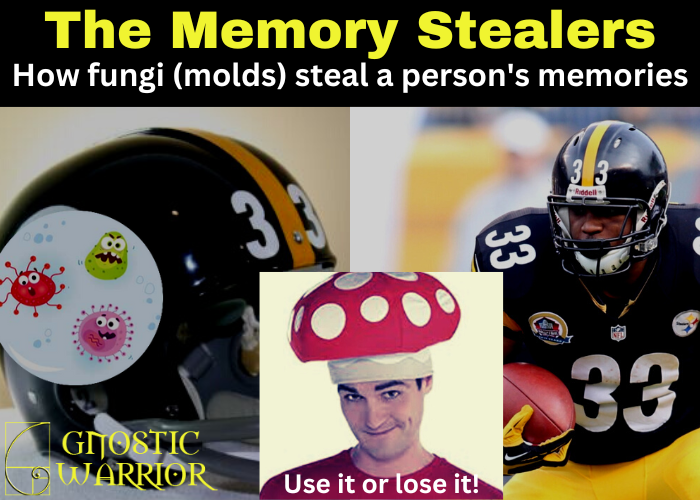
by Moe | Jan 21, 2023 | Demons, Duality, Free Will, Mind Control Research
Alzheimer’s disease (AD) is a progressive brain disorder that destroys memory and thinking skills, ultimately causing an inability to perform even simple tasks. It also causes a significant slowdown in a person’s brainwave frequency activity to the point they could be medically described as living in a permanent sleep-like state.
In addition, people with this disease experience atrophy of the brain, which simply means that it is decaying or wasting away. (1) Hence, the old adage, use it or lose it applies to not only brain function, but whether you will have use of your mind, cognition, and memories as you age.

The same thing occurs to your muscles which is medically described as the wasting (thinning) or loss of muscle tissue. The main cause of atrophy is lack of physical activity or disuse (physiologic) of muscles occurs when you don’t use them enough.
As it related to atrophy of the brain, this is what I contend is one of the main causes of dementia and Alzheimer’s Disease worldwide. I believe this wasting away is the result of not actively using your brain on a regular basis to process and learn new information.
The resulting effects of this atrophy allow our microbiome and in particular, fungi to commandeer our cells, neurons, and central nervous system via our gastrointestinal tracts to induce a loss of consciousness or a sleep-like waking state.
As if we have biological laws programmed into our genes that supersede all human-made legal systems and structures that determine our fates. One of these ancient legal codes for not using our brains is to have them slowly eaten from within and wiped clean of all memories attained in this life.
What better and more sinister way than to have the very microbes within our body, blood, and organs be the very legislators of all life?
As it is related to dementia and Alzheimer’s, it is the fungi working within their central nervous system and brains that is turning off certain normal autonomous functions to make them sleep while they are awake in a covert biological attempt to control their minds as it steals their memories.
For example, a 2012 study found that fungal pathogens within the gut microbiota, which are normally well tolerated, may disseminate via the circulation to other sites including the brain leading to a systemic fungal infection, resulting in significant pathology and mortality (Brown et al., 2012).
Several studies have shown that the autopsied brains of Alzheimer’s patients reveal that they are infected with often multiple types of fungi (molds).
Fungal infections have also been widely observed in their blood vessels, which may explain why people who have Alzheimer’s also suffer from vascular pathology.
This is interesting given the fact that it appears to be a memory stealer and brain eater. It makes sense then that fungi may be the culprit responsible for this mind-decaying disease.
But this knowledge has been known by scientists for well over one hundred years.
In 1910, Czech psychiatrist, and an expert on dementia and Alzheimer’s disease, Oskar Fischer, proposed that these diseases were caused by foreign bodies in the brain, most likely fungi, which provoked inflammation and amyloid plaques (see Eikelenboom et al., 2006; Goedert, 2009; Mar 2009 conference news).
In his 1907 paper, Alzheimer described the presence of plaques and tangles in one case of presenile dementia, whereas Fischer described neuritic plaques in 12 cases of senile dementia. These were landmark findings in the history of research in dementia because they delineated the clinicopathological entity that is now known as Alzheimer’s disease.
in 2014, compelling evidence for the existence of fungal proteins in brain samples from Alzheimer’s disease patients. The study titled, “Fungal infection in patients with Alzheimer’s disease,” stated “a variety of fungal species in these samples, dependent on the patient and the tissue tested.
DNA sequencing demonstrated that several fungal species could be found in brain samples. Together, these results show that fungal macromolecules can be detected in the brains of Alzheimer’s disease patients. To our knowledge, these findings represent the first evidence that fungal infection is detectable in brain samples from Alzheimer’s disease patients.” (2)
A 2015 study titled, “Different Brain Regions are Infected with Fungi in Alzheimer’s Disease (AD),” showed the possibility that AD is a fungal disease, or that fungal infection is a risk factor for the disease. The researchers provided evidence in the study that tissue from the central nervous system (CNS) of AD patients contained fungal cells and hyphae.
According to the researchers, “Different brain regions including external frontal cortex, cerebellar hemisphere, entorhinal cortex/hippocampus and choroid plexus contain fungal material, which is absent in brain tissue from control individuals. Analysis of brain sections from ten additional AD patients reveals that all are infected with fungi.
Eleven patients (plus three additional CP samples) were described in this study, as well as in four patients previously analyzed, there is clear evidence for fungal cells inside neurons or extracellularly.
Therefore, 100% of the AD patients analyzed thus far by our laboratory presented fungal cells and fungal material in brain sections.
Moreover, fungal macromolecules (polysaccharides, proteins and DNA) have been found in blood serum from AD patients, and fungal proteins and DNA were detected by proteomic analyses and PCR, respectively, from frozen tissue of AD brain.
Collectively, our findings provide compelling evidence for the existence of fungal infection in the CNS from AD patients, but not in control individuals. (3)
A 2003 study titled, “How a Slime Mold Came to the Aid of Alzheimer’s Research,” details how a structure called a “Hirano body” found in a slime mold is present in increased amounts in Alzheimer’s patients.
It is mostly present in the brain’s major site of learning and memory, the hippocampus.
The study reports, “What causes neurodegenerative diseases like the most common early symptom of Alzheimer’s which is difficulty remembering newly learned information because Alzheimer’s changes typically begin in the part of the brain that affects learning, is still largely unknown, but something destroys nerve cells in the brain over a period of time as victims gradually lose their minds.”
Numerous studies suggest that the accumulation of beta-amyloid peptides (betaAP) plays a central role in the pathogenesis of Alzheimer’s disease. It is well established that betaAP has a wide range of toxic effects on neurons and we can connect their production in the human body to fungi.
The amyloid-beta precursor protein is an important example. It is a large membrane protein that normally plays an essential role in neural growth and repair. However, later in life, a corrupted form can destroy nerve cells, leading to the loss of thought and memory.
Scientists at the Stanford University School of Medicine have shown how the disease is strongly correlated with the overproduction and accumulation of amyloid-β peptide, which begins destroying synapses before it clumps into plaques that lead to nerve cell death.
A 2009 study found that the amyloid-β peptide induced depolarization of skeletal muscle plasma membranes can significantly disturb the functioning of skeletal muscles and therefore contribute to motor dysfunction observed in Alzheimer’s disease and other disorders associated with βAP accumulation.
Depolarization causes the rapid change in membrane potential from a negative to a positive state. The process of depolarization begins with a stimulus like fungi.
Brainwave activity is related to oscillatory activity at different frequencies ranging from 2–4 Hz (delta), 4–8 Hz (theta), 8–13 Hz (alpha), 13–30 Hz (beta), and >30 Hz (gamma). These frequencies transmit certain physiological information on the brain’s functional state during wake and sleep cycles.
The EEG findings of patients with Alzheimer’s disease show a slowing of alpha activity and an increase in slow-frequency activity
A few studies have shown a significant increase in delta and theta power in conjunction with a decrease in alpha and beta power over a period of two years from diagnosis of dementia. In another study, significant increases in delta and theta were found with a decrease in beta, alpha, and mean frequency.
The awakened state is medically described as being in the alpha frequency, which is mainly related to a person’s global attentional readiness. Alpha rhythms represent the dominant resting oscillations of an awakened human brain and have been linked to intelligent quotient, memory, and cognition. (5)
SOURCES:
1. Electroencephalographic Rhythms in Alzheimer’s Disease
2. PubMed: Fungal infection in patients with Alzheimer’s disease
3. PubMed: Different Brain Regions are Infected with Fungi in Alzheimer’s Disease
4. PubMed: Different Brain Regions are Infected with Fungi in Alzheimer’s Disease
5. https://www.ncbi.nlm.nih.gov/pmc/articles/PMC3100729/
Moe is the founder of GnosticWarrior.com. He is a father, husband, author, martial arts black belt, and an expert in Gnosticism, the occult, and esotericism.
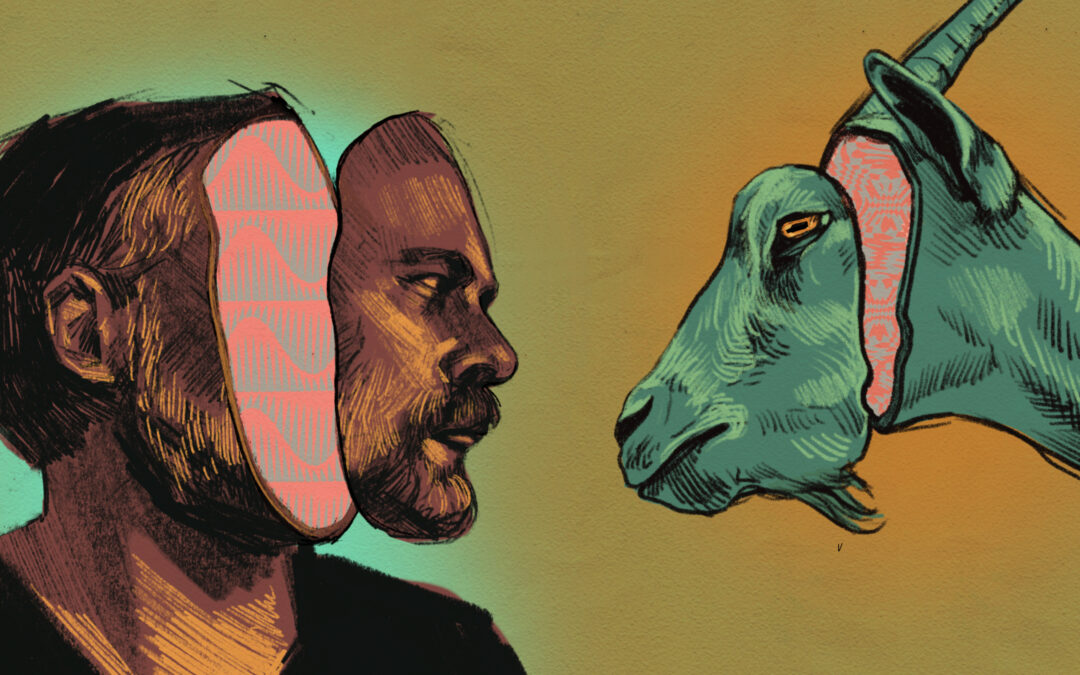
by Moe | Jan 5, 2023 | Demons, Gnosis, Philosophy
A common theme you will find in Philip K. Dick’s writings is the concept of people who do not act human due to their behaviors and how they treat other people.
He claimed that a person who lacks the ethics, empathy, and sincerity that are seen as defining humanity can be considered an android, which he says is “a metaphor for people who are physiologically human but psychologically behaving in a non-human way.”
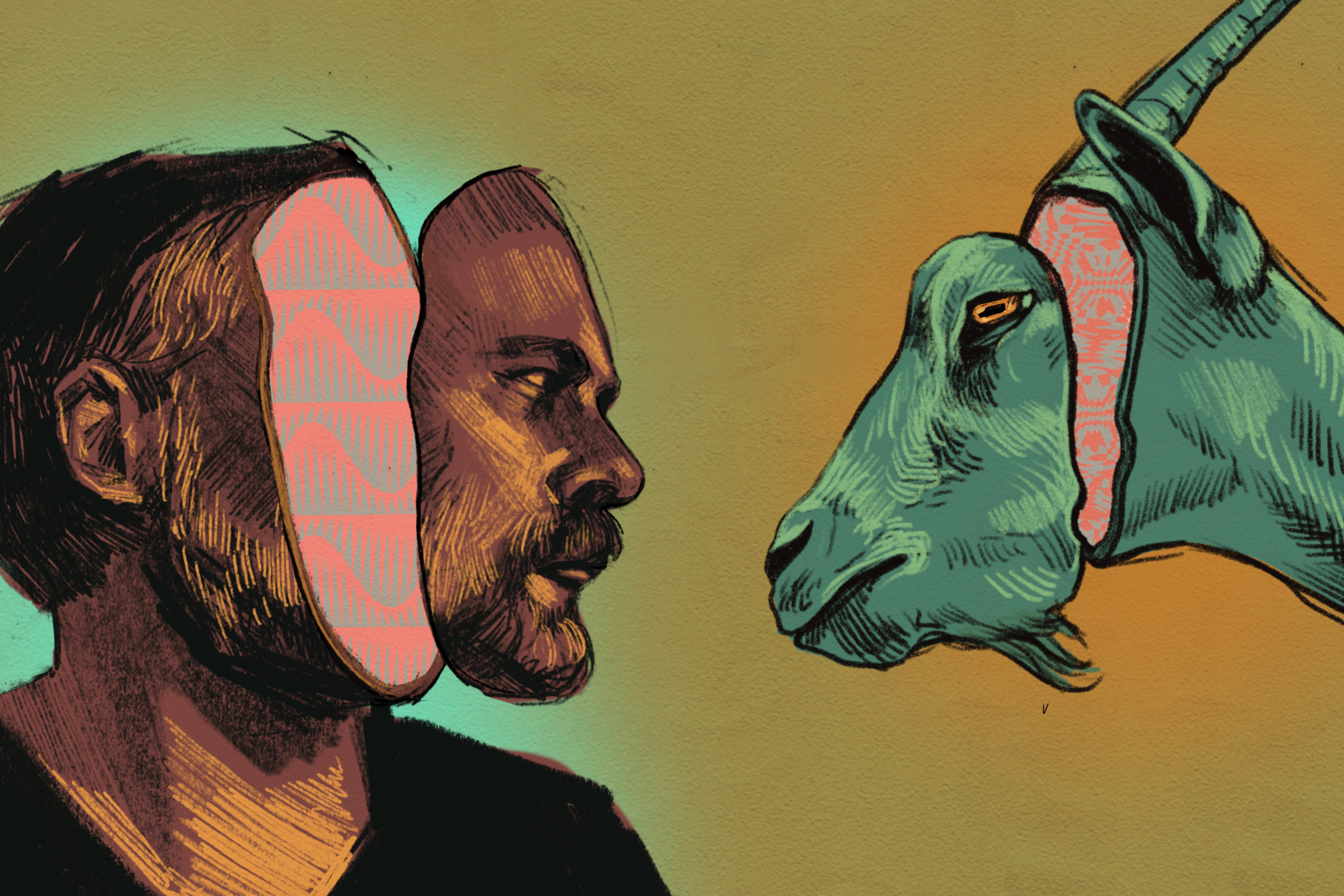
“The android, by definition, is not human,” Dick wrote. “He is an imitation, a copy of an original. And he must be treated as such.”
The difference between people and androids doesn’t lie in their biological characteristics, but rather in their actions and behaviors. Any person who is compassionate toward others can be called a person; those who lack empathy aren’t human but something else altogether.
Dick says this is especially true if that person has been programmed by their parents or society to live in such a way that they lack empathy towards others.
He called these people manufactured human beings who were much like androids. They can be considered to be “manlike” because they are often made in their image and resemble human beings.
“Androids,” Dick wrote, “are manufactured beings almost identical to real human beings.
He said the android was “a thing somehow generated to deceive us in a cruel way, to cause us to think it to be one of ourselves.”
Dick was also infamous for his claims that many people’s lives were controlled by external forces. That we live in a type of computer simulation.
A theme he used to describe this world was “The Black Iron Prison” of the “Empire (Roman) that never ended.”
In many of his books, androids can have biological and mechanical parts to make them indistinguishable from humans. They can be genetically modified clones of humans (as in Clans of the Alphane Moon).
“An android'” Dick said, “doesn´t care what happens to another android. That´s some of the indications we are looking for.” (Dick 2007, 88).
When a person does not care about how other people feel and just does whatever they want, they are said to lack empathy and sympathy. They can be even diagnosed as sociopathic and even psychopathic if their behavior gets worse.
According to the Oxford Dictionary and the Oxford Advanced Learner´s Dictionary, empathy derived from the Greek term “empatheia” and means “the ability to understand another person´s feelings, experience, etc.”
People who lack empathy have the inability to put oneself in the position of someone else or simply do not care. This is the opposite of the Christian ethos of treating others how you want to be treated or the Freemasonic concept of Brotherly Love.
Dick was interested in artificial intelligence from an early age: he studied philosophy at Berkeley and wrote his first novel — Solar Lottery — while still in his 20s.
The book features a robot who looks like Elvis Presley and is able to sing like him too — which makes it clear that Dick knew about AI long before computers were powerful enough to create anything like it (or even before anyone had thought of making one).
Among the examples of androids in the modern world, Dick sees the unethical and immoral behavior of the German Nazi’s and the police state in which he predicts a future where we would all live in a surveillance society.
Dick had researched the behavior of the Nazis and their treacherous murder campaigns of millions of people. He read how often many of these Germans who became Nazi’s were highly intelligent but emotionally “so defective that the word human could not properly be applied” to them.
This led Dick to a study of “the problem of differentiating the authentic human being from the reflex machine I call an android.”
Dick’s 1956 story “The Android and the Human” is a classic that tells the story of an android that is programed to behave like a human being, but cannot feel empathy or compassion for other humans. This behavior leads to the scientists who created the androids to question what makes us human.
In a lecture on “The Android and the Human” in 1972, Dick discussed the difference between an android and a human. He said;
“I strongly suspect that we will discover in the 21st century that what makes us human is not our physical bodies or our biological processes but rather our minds — our minds in whatever shapes they take — and if we can find ways to communicate with other intelligences we may find that they are not all physical at all.”
Dick said, “…an android means, as I said, to allow oneself to become a means, or to be pounded down, manipulated, made into a means without one’s consent—the results are the same. But you cannot turn a human into an android if that human is going to break laws every chance he gets.”
Androidization requires obedience.
And, most of all, predictability. It is precisely when a given person’s response to any given situation can be predicted with scientific accuracy that the gates are open for the wholesale production of the android life form,” he says.
Dick says, “Some meaningful comparison exists between human and mechanical behavior as the external world becomes more animate, we may find that we—the so-called humans— are becoming.. .inanimate in the sense that we are led, directed by built-in tropisms, rather than leading. So we and our elaborately evolving computers may meet each other half way.”
In his novel “Do Androids Dream of Electric Sheep?”, he explores what it means to be human through the eyes of Rick Deckard (the main character) who hunts down rogue androids that are trying to blend into society without being detected.
In his novel “A Scanner Darkly”, he takes this idea further by exploring how people can become addicted to drugs and how they lose their humanity as they continue to use them over time.
HISTORY OF ANDROIDS
The term android was used before Dick to describe a robot that looks like a human being.
The word was first coined by John Stuart Mill (1806-1873) in his book “A System of Logic” (1843). He said:
“Let us conceive a machine as nearly resembling a human being as possible in outward shape and motion, but constructed of metal and possessed of no other faculties than those which would enable it to walk, handle materials and perform particular operations.”
Later it was used by playwriter, Karel Capek (1890-1938) who is credited with inventing the word “robot” in his play “R.U.R.” (1920).
The Ancient Greeks gave us the first concept of an android or human like creature they called Beast (thēríon) and ‘αὐτῷ (autō),’ meaning “He, she, it, they, them” and use of the “third person, and of the other persons.”
So when we read Beast, we understand that this represents a person, and I contend it is from the Greek word ‘αὐτῷ (autō), where we get the word automatic and the adjective to describe a person who acts like a robot as an “automaton.”
The word “automaton” is the Latinization of the Greek αὐτόματον, automaton, meaning “acting of one’s own will”. The Hellenistic world’s automata were intended as tools, toys, religious spectacles, or prototypes for demonstrating basic scientific principles.
A person who is an automaton acts like a Beast because they would be similar to the meaning, which is “a moving mechanical device made in imitation of a human being.”
These philosophical teachings of the Greeks became part of our Bibles. For example, in the New Testament, the Greek Beast (thēríon) and ‘αὐτῷ (autō) is derived from the Hebrew word behamah, which means “human-animal” or, more appropriately, a “stupid or ignorant person”.
THE DEVIL HAS A METAL FACE
These people who he called androids would act fake and appear to be good humans. But they were wearing what he called a “Devil’s mask.”
Dick wrote;
“My theme for years in my writing has been, “The devil has a metal face.” Perhaps this should be amended now.
What I glimpsed and then wrote about was in fact not a face; it was a mask over a face. And the true face is the reverse of the mask.
Of course it would be. You do not place fierce cold metal over fierce cold metal. You place it over soft flesh, as the harmless moth adorns itself artfully to terrorize others with ocelli.
This is a defensive measure, and if it works, the predator returns to his lair grumbling, “I saw the most frightening creature in the sky — wild grimaces and flappings, stingers and poisons.”
His kin are impressed. The magic works.
I had supposed that only bad people wore frightening masks, but you can see now that I fell for the magic of the mask, its dreadful frightening magic, its illusion. I brought the deception and fled.
I wish know to apologize for preaching that deception to you as something genuine: I’ve had you all sitting around the campfire with our eyes wide with alarm as I tell tales of the hideous monsters I encountered; my voyage of discovery ended in terrifying visions which I dutifully carried home with me as I fled back to safety.
Safety from what? From something which, when the need was gone for concealment, smiled and revealed its harmlessness.
Now I do not intend to abandon my dichotomy between what I call “human” and what I call “android,” the latter being a cruel and cheap mockery of the former for base ends. But I had been going on surface appearances; to distinguish the categories more cunning is required.
For if a gentle, harmless life conceals itself behind a frightening war-mask, then it is likely that behind gentle and loving masks there can conceal itself a vicious slayer of men’s souls.
In neither case can we go on surface appearance; we must penetrate to the heart of each, to the heart of the subject.
Probably everything in the universe serves a good end — I mean, it serves the universe’s goals.
But intrinsic portions or subsystems can be takers of life. We must deal with them as such, without reference to their role in the total structure.
GNOSTIC WARRIOR CONCLUSION
In the era Philip K. Dick had lived, there was widespread panic in the U.S. about artificial intelligence and computers taking over our lives and the world.
His books and stories that also became movies like Total Recall seemed to fuel fear rather than abate it.
Dick often described himself as being paranoid.
The Sepher Yezirah, a Cabbalist text, “The Book of Creation,” which is almost 2,000 years old, tells us:
“God has also set the one over agaist the other; the good against the evil, and the evil against the good; the good proceeds from the good, and the evil from the evil; the good purifies the bad, and the bad the good; the good is preserved for the good, and the evil for the bad ones.”
Underlying the two game-players there is God, who is neither and both.
The effect of the game is that both players become purified. Thus, the ancient Hebrew monotheism, so superior to our own view.
We are creatures in a game with our affinities and aversions predetermined for us — not by blind chance but by patient, foresighted engramming systems which we dimly see.
Were we to see them clearly, we would abolish the game. Evidently that would not serve anyone’s interests.
We must trust these tropisms, and anyhow we have no choice — not until the tropisms lift. And under certain circumstances they can and do.
And at that point, much is clear which previously was occluded from us, intentionally.”
Among the examples of androids in the modern world, Dick sees the unethical and immoral behavior of the German Nazi’s and the police state in which he predicts a future where we would all live in a surveillance society.
A future that today many of us are living in as a fact.
Moe is the founder of GnosticWarrior.com. He is a father, husband, author, martial arts black belt, and an expert in Gnosticism, the occult, and esotericism.

by Moe | Oct 30, 2022 | Demons, Magic, Satanism
In 1993, three innocent young kids were found raped, naked, and murdered in the mud of local woodland at Robin Hood Hills in West Memphis, Arkansas.
They were all American boys – 8-year-old Michael Moore, Steven Branch, and Christopher Byers. All proud members of the Boy Scouts with the world ahead of them but their lives were cut short in the most horrible way that anyone could ever imagine.
After getting together to go play and have fun in the local woods, the boys were instead abducted, tied up, beaten, raped, tortured, and then killed in what can be described as a “Satanic ritual sacrifice.”

According to the Encycopledia of Arkansas:
“The state of the boys’ bodies quickly inspired rumors that a satanic cult was responsible. The crime scene’s location in the woods, the nudity, the positioning of the boys’ bodies, and especially the castration caused concern about Satanism amongst the locals, and amongst the police as well.
Within days of the murders, Gary Gitchell, the chief inspector, informed the public that the police were considering a number of possible explanations for the murders, one of which was cult activity.
Throughout the investigation, the cult theory overshadowed more traditional theories, such as the speculation that the murders were committed by someone who knew the boys.”
At the time of the killings, a local teenager from a nearby trailer park named Damien Echols quickly became a prime suspect. The main reason why police zeroed in on Echols was his criminal record, extensive mental health history, and his interest in the occult.
You see, Echols was a felon and his probation officer who knew his dark history had alerted homicide detectives about his tendency for violence, and his involvement in Satanism, black magick, and the fact that he had threatened to murder people in the past – including his own step mother.
Echols was not your average heavy metal tshirt wearing teenager.
He was a Satanist who was a convicted criminal who had a long history of dark occult and blood ritualistic behavior.

According to police and mental health records, Damien Echols had made a pact with his girlfriend to sacrifice their first born baby in a death ritual and that he liked to drink human blood as well.
When he was arrested, police investigators discovered a plethora of evidence of Echols occult and Satanic activities with various writings, drawings, and his own and other people’s damning statements.
For example, Echols had a ringed binder in his possession at his home that he made called the “Book of Shadows” with Satanic drawings such as these:


As I mentioned, there has been a lot written about the case from both perspectives so I won’t go into too much detail here other than summarizing the key points that I believe are the most important to prove that Damien Echols was and is a Satanist on the fringe.
It is important to note that one of the main suspects, Jessie Misskelley had confessed not once, not twice, but several times to law enforcement and he even placed his right hand on the bible admitting the killings. Later he would also confess to his lawyer. Hell, even his own father and family believed he was guilty.
The police then investigated into his background and what he was doing on the night of the murders. An eyewitness had seen Echols with another person in the very same neighborhood the boys were found dead covered in mud.
Damien along with two of his friends, Jason Baldwin, and Jessie Misskelley, were then questioned and arrested for the crimes and they would forever be known in Cult murder lore as “The West Memphis Three (3).”

Misskelley had quickly confessed to detectives about his involvement giving them intimate details of the crime scene such as being hogtied and having chased down one of the boys who almost got away, and he also implicated Baldwin and Echols as his accomplices.
He had told investigators;
“Then they tied them up, tied their hands up,” parts of which were tape recorded. After describing sodomizing and other violence, he went on: “And I saw it and turned around and looked, and then I took off running. I went home, then they called me and asked me, ‘How come I didn’t stay? I told them, I just couldn’t.’”
Misskelley later recanted, and defense lawyers said the then-17-year-old got several parts of the story wrong.
But that was not the only evidence and there were also other statements made to police that prove that The West Memphis 3 were violent teens who also practiced Satanic rituals.
For example, one of Jessee Miskelleys’ friends, Dennis Carter was interviewed by Lt. D. Hester at the request of Dennis Carter 6/9/93 completed @ 2:45 – 4:15 p.m.
According to the police report, Carter told police that he has known and been friends with Misskelley all of his life.
The last time he saw Jesse was the day before he was arrested. He claimed that he did not know Damien or Jason. However, he knew who they were but was not friends with either of them.
One of their mutual friends, Rick told Dennis about some Devil worshipers that would meet in a place called Stone Henge in the woods where they would cut a dog’s head off and would eat the meat from the leg. Rick said that Damien was the leader.
Dennis told investigators that about 6 months prior, Jesse told him that Damien was a Devil worshiper and that he ate the right leg of dogs and said that this happened in the woods located behind Elite lamp.
He also said to the police that Jesse liked to fight and a lot of times he would even start it. About 2 months prior to the crimes, Jesse was fighting a boy named Eric in Lakeshore when this girl named Tiffany (13) Eric’s girlfriend — went over to try and stop him — states Jesse turned around and hit her as hard as he could in the ear with his fist. Dennis stated that Jesse had to go to Juvenile Court over that.
Dennis said there was a little girl in the mobile home park who was 5 or 6 yrs old who was throwing rocks — one accidentally hit Jesse — Jesse chased the little girl and threw a rock and hit her in the head. The little girl was crying and Jesse was laughing.
He also stated to police that Jesse drank a lot and smoked pot when he could get it — thinks the guys name is Josh 17 yrs old and lives in Highland Trailer Park. States that he also saw Jesse sniffing gas about 20 times. Also saw Jesse take mini thins — bought them at Delta in Marion — got high from those.”
Damien Echols would fail a polygraph test and his alibis would be ripped to shreds. He even admitted on the stand that his timeline kept changing to try to fit the facts.
We know that after a short trial, the jury convicted the three teenagers of the crimes in 1994 based on the evidence put forth by the prosecution with the most damning being the actual confessions from two of the killers.
In upholding Echols’ conviction in 1996, the state Supreme Court noted that two people testified Echols bragged about the killings, an eyewitness put Echols at the scene, fibers similar to the boys’ clothing were found in Echols’ home, a knife was found in a pond behind Baldwin’s home, Echols’ interest in the occult and his telling police that he understood the boys had been mutilated before officers had released such details.
Since the deaths of the three boys, there have been countless articles, books, and even Hollywood films detailing some of the facts about the case and legal battles. What I have found in my own research is that there are two different camps of people who have taken opposite sides on this matter.
One camp still adamantly believes that Damien Echols and his accomplices are guilty and the other camp believes that they were innocent teens who were wrongly convicted simply because they loved heavy metal and wore Metallica t-shirts.
The camp who believes he is guilty is still very active online. Many people have started personal websites, wrote books, and have active Facebook Groups where they are still covering this case and keeping a watchful eye on who Echols who they feel is a serious threat to society.
The other camp who professes his innocence rely on the simple defense asserting that the killings were part of a Satanic Panic by over zealous Christians and Prosecuters, inspired many authors and film makers to document the case, and led to a movement of powerful people and Hollywood stars who believed that the Memphis 3 had been wrongly convicted.
These people with the help of Hollywood star power and millions of dollars would end up helping the three convicts released from prison. Their supporters would include, “Lord of the Rings” director, Peter Jackson, who donated millions of dollars and “actors” like Johnny Depp, Natlie Maines of the “Dixie Chicks,” and Eddie Vedder of “Pearl Jam.”
It has been estimated that they contributed approximately $20 million to help defend the convicted child killers by dragging out the appeals process, which eventually would secure their release from prison in 2011.
One of the main reasons I feel compelled to report on this case is because Damien Echols is now openly claiming to be a Satanist who used black magick and what he had coined as ‘High Magick” to get off Death Row for the murders of 3 innocent boys.
Also, the fact that the West Memphis Three had received millions of dollars for their defense fund from a bunch of celebrities and got a lot of media attention from Hollywood.
All because some people had characterized their prosecution as the result of a Satanic Panic and overzealous law enforcement who busted three local teens just because they were into heavy metal and wore Metallica t-shirts.
On August 19, 2011, after serving 18 years of Death Row, the convicted child killers – Echols and his co-defendants in the case, Jason Baldwin and Jessie Misskelley Jr., entered Alford pleas. An Alford plea is a no contest plea where the accused claims their innocence, but pleads guilty anyway to get a deal offered by prosecutors instead of risking a trial.
During the hearings, after years of investigation and millions of dollars spent by the Memphis 3, the defense attorneys, nor the defendants did not present any exonerating evidence to prove their innocence during the Alford Plea hearings.
Despite there being no evidence proving their innocence, the three men admitted their guilt in the crimes, Arkansas Judge David Laser accepted the pleas and released the men for time served with 10-year suspended sentences.
But the facts are that there is more to the story than Hollywood and the West Memphis 3 would like you to falsely believe. This story of child rape, torture, and murder and celebrities raising millions to release three convicted criminals is a perfect example of why I believe that the U.S. has devolved from our original ethos of Brothery Love and justice and liberty for all into the “Satanic State of America.”
In researching the case, I discovered that this outcast rage would be the main marketing calling card for West Memphis Three and their 3 Hollywood made movies which would convince many people around the world that they were just different – outcasts like you and me.
In fact, this is how they continue to convince people that they are innocent through these films and the many articles written by lazy journalists who consume Echol’s narrative hook, line, and sinker just because they saw the movie or read some article.
What people need to understand about this case are the facts that the people who backed up Damien Echols and the producers who made the films failed to include many facts, details and evidence that would have revealed a much different side of the case than they wanted to portray to their audience.
An audience they knew most likely would not do their own research so they included only the facts they wanted to put in the film to control the narrative in order to gain support and money for Echols’ cause.
And you know what?
Almost every person I have researched who believes the West Memphis Three are innocent based their beliefs mainly from watching the Damien Echols directed movies. Including one of his biggest supporters and who he calls his Brother, Johnny Depp.
They even have matching secret demon and talisman tattoos on their chests to signify their occult bonds.

Marilyn Manson calls them “The West Hollywood Three” which is a pun on the name West Memphis Three. A name that was given to Echols and his two convicted child pals in the rape and torture of 3 boys in Memphis, Tennessee.

USA Today reports on Depp’s statements about the matching tattoos;
“The man Johnny Depp helped release from Arkansas’ death row has become like a brother to him, right down to getting matching tattoos.
“We have some,” Depp said Saturday as he touched a tattoo on the right side of his chest.
“This one Damien designed. It’s one of my all-time favorites, and it means quite a lot to me,” Depp told The Associated Press before the premiere of the documentary, “West of Memphis,” about Damien Echols and his two co-defendants.
Echols said whenever he and Depp get together, they often end up in a tattoo parlor. Depp said it’s about “celebrating the moment.”
A fact that you need to know is that Damien Echols was the executive director of the films which played a huge part in securing his release.
This meant that he had the final say in what information will be presented in the film and what they will not be shown to the public.
When I discovered that Echols was the executive director, I immediately thought “How many convicts would love to receive millions of dollars for their defense and to direct a movie to secure their release telling the public about only the details of the crime that they would like them to believe?”
In my opinion, that is a lot of magical power to hand to a convicted child raping killer who is on Death Row. In fact, this has never happened in the history of our justice system.
As the author, Gary Meece points out in his book, Blood on Black: The Case Against the West Memphis 3 Killers, which is unlike the other books and documentaries about these crimes because he actually uses real court case files. Meece wrote:
“The murders were thrill kills, according to Echols himself. But they were much more than that. Police were struck by the ritualistic aspects. Local dabblers in the occult immediately came under suspicion.
Under questioning, Echols, already acknowledged as a witch, flaunted his knowledge of the occult, his theories of how the killings could have “magickal” implications and his insights into how the killer would think and feel.
He demonstrated special knowledge about the case beyond the little publicly known. He gave out signals that he was a prime suspect; a series of witnesses further implicated him. A confession broke open the case.”
All these facts were mysteriously left out of the movie script… I wonder why?
What is also left out of the film is over 500 pages of mental health records saying things like Echols was prone to extreme acts of violence, liked to drink human blood and threatened to kill and eat people like his own father.
These 500 pages are known in the West Memphis Three case filed as “Exhibit 500.”
It includes most of the hospitalization and mental health records of Damien Echols as a teenager while he lived in Arkansas and Oregon and also his application for disability. Yes, he applied for disability due to his inability to function as a normal person due to his severe mental health issues and thus keep a job.

It is a large collection of mental health status records, psychological testing, dozens of damaging notes by mental health doctors and nurses and also includes statements from Jerry Driver, Damien’s parole officer.
Here is a small example of some pertinent facts you should know about Damien Echols before the murders.
Harming self
* Suicidal.
* Made a suicide pact with Deanna Holcomb.
* Self-mutilation (cutting and burning).
* History of drug abuse.
Violent threats or ideation
* Threatened harm to or threatened life of Pamela Echols (mother).
* Threatened harm to or threatened life of Joe Hutchison (father).
* Threatened harm to or threatened life of father of Deanna Holcomb (girlfriend).
* Threats/terroristic threatening, others.
* Murderous ideation.
Violent acts and attempted acts of aggression.
* Chased child with ax.
* Initiates fights at school/aggression toward others.
* Attempted to claw out schoolmate’s eyes.
* Started fires.
Belief system/behaviors
* Witchcraft interest and practice.
* Satanism, occultism or devil worship.
* Possessed by a spirit or demon.
* Drank blood of peers (voluntary or involuntary).
* Claimed to be a vampire.
* Planned to have baby and sacrifice it.
* Wrote disturbing, dark, or occult (or satanic) poetry.
* Made occult (or satanic) drawings.
Damien Echol’s long history of family dysfunction, mental health issues, violence, and sexual abuse were the main themes that can be found in the Exhibit 500 documents and in later witness statements taken after his arrest.
In these records, Echols had said to various psychiatrists and therapists that he had no feelings for his family and that he hated both his step-father and biological father and that he did not like his sister because “she want(ed) to be like him and that bothers him a lot.”
His mother said Damien’s biological father may have been physically abusive and once threatened to break Damien’s arm. His stepfather was accused of being sexually abusive, and possessive toward his mother, and was “mentally abusive” to his step-children.
An interesting note is that Damien is not his birth name. He was born Michael Wayne Echols and he changed his name as a teenager from Michael to Damien. Damien said both in trial and to a social worker in 1992, that he was the reason behind the name change.
He claimed that he had been interested in Catholicism at the time and admired Father Damien, who tended to lepers on Molokai. But many people allege that he took the name himself after the boy in The Omen who was really a demon.
Damien’s first stay at a mental hospital was at the Charter Hospital in Little Rock after threatening to commit suicide after being arrested for burglary, sexual misconduct, and breaking and entering involving an incident with his then girlfriend and her parents. Damien was sent to the hospital after expressing plans to commit suicide in the detention facility.
From the numerous reports compiled there, we can start to see a more complete version of Damien’s mental health and occult history.
Damien said that he had been suspended from school seven times for setting fires. He also mentioned a fight with a classmate over a girl, where he almost gouged out his eyes. The classmate was questioned and the incident was found to be true. There was a time when Damien chased a child with an axe, but Echols would later deny the event happened.
The hospital staff confirmed that he had a history of physical aggression and felt that his peers at school taunted him. They observed Echols daily, and took a lot of notes referring to him as being “depressed” and “withdrawn”, with a “flat affect”. He told the hospital that he had burned himself with lighters, and huffed gas and paint
Echol’s mother expressed concern to the hospital about her son’s “anger and rage”. His MMPI evaluation (which begins on page 199) also made note of Damien’s apparent “impulsive hostility” and how he may “feel justified in treating others in an unprincipled matter” due to perceived wrongs.
The mental health staff noted that he may have been suffering from paranoia and auditory hallucinations, due to sniffing the air and giving “inappropriate smiles.” The MMPI evaluation diagnosed him with depressive disorder, bipolar, and paranoid schizophrenia. Echols claimed at his trial that he was on medication for manic depressive behavior, though what was prescribed to him (Tofranil) is actually an anti-depressant and is known to make manic behavior worst.
In 1992, while incarcerated at the Craighead County Detention Center in September of 1992, after it was found that he drank the blood that came from a peer, he was transferred to the Charter Hospital of Little Rock for observation.
Details about the incident are contradicted by Echols who claimed that the person had allowed him to suck blood from his neck but the incident report from the Juvenile Detention Center said that Damien had sucked blood from a peer’s arm without warning.
In an interview on September 15, 1992, a social worker claimed that Echols discussed his devil-worshippingiefs in vampirism. The social worker also claimed that Damien was giggling and smiling at inappropriate moments, during this interview.
The initial evaluation also stated that his peers at the detention center were afraid of him and that he showed poor judgment and had little insight into his illness. They also noted that Damien seemed cooperative but drew occult symbols, which concerned them.
In early 1993, Echols attended more counseling when he claimed to his therapist that his “parents were constantly fighting” and that he had “tried to ignore it but eventually started fighting back.”
During the evaluation, he made various disturbing statements that proved that he was a hardcore Satanist who performed blood rituals.
Echols said to the therapist that he wanted to “go where the monsters go when I die” and that he “hated the human race.” He talked often about his beliefs in witchcraft, but claimed that he was not part of a cult. Echols said that he drank blood to feel power, though it had to come from a sexual or ruling partner.
He said that he had a spirit living inside of him and communicated with demons through rituals and admitted that due to his anger, he blew up sometimes and wanted to hurt other people.
Shortly after he was released from the hospital, Echols applied for SSI disability benefits.
As I had mentioned, the West Memphis Three case had got a lot of attention from Hollywood because some people had wrongly characterized their prosecution as the result of a Satanic Panic and overzealous law enforcement who busted Echols and two other teens just because they were into heavy metal and wore Metallica t-shirts.
A movie was made that was funded by people such as Johnny Depp, Eddie Vedder, and Marilyn Manson and directed by Damien Echols himself. In my opinion, that is a lot of magical power and money to hand to a convicted child-raping killing Satanist who is on Death Row.
As you can witness for yourself with the multiple confessions of one of the murderers and the facts documented in Echols mental health records via Exhibit 500, Damien was a hardcore Satanist with a lust for violence and liked to consume human blood.
He was not part of some local cult or organized Satanic sect, but like most people who commit crimes like this, he suffered from family problems, mental health and drug issues. He had a tendency for violence and a taste for human blood.
Fast forward to today and you will find Damien Echols free as a bird and happy as a Satanic clam.
Echols sells books on “High Magick” and demon sigils in his online store that he claims helped him get out of prison and you know what, I believe him 100%.
He is writing books teaching kids and adults on his popular Youtube channel. Dark wisdom that he dispenses to anyone and everyone showing the very magic that he used to escape from Death Row for the rape, torture, and murder of three boys that he “allegedly did not commit.”
In addition to his books, Youtube and Twitter, he also receives thousands of dollars a month on Patreon.
But let me remind you that he and his accomplices pleaded guilty to the crimes on two occasions.
They were never proved to be innocent or exonerated for the rape and murder of the three innocent boys.
Moe is the founder of GnosticWarrior.com. He is a father, husband, author, martial arts black belt, and an expert in Gnosticism, the occult, and esotericism.

by Moe | Jul 4, 2022 | Demons, Magic, Satanism
Some people call it, “The House of the Devil.” While others, “The House of Sin.”
What we do know for sure is that Aleister Crowley purchased the Boleskine House in Scotland along the banks of Loch Ness for the sole purpose of performing black magick rituals and summoning demons when he lived there between 1899 and 1913.

Crowley was just 25 years old when he bought the home in 1899 after looking for the perfect location to carry out a series of rituals from the Book of Sacred Magick Abremelin Merlin of Mage.
The Boleskine House was the right spot because it was very secluded so he could carry out his rituals in solitude without the prying eyes of his neighbors. It also had the right architecture and was situated near an old cemetery, which was perfect for spirit conjuring.
This was also the same location where a blaze occurred during a church congregation – and killed everyone inside. Interestingly, this same site is near the banks of the home to one of the world’s most famous monsters, Loch Ness.
Crowley wrote in his autobiography, The Confessions of Aleister Crowley; “I had picked out Boleskine for its loneliness. Lord Lovat and Mrs Fraser-Tytler, my nearest neighbors, were eight miles away, while Grant of Glenmoriston was on the other side of Loch Ness.”
According to Crowley, in order to perform the operations, “the first essential is a house in a more or less secluded situation. There should be a door opening to the north from the room of which you make your oratory.
Outside this door, you construct a terrace covered with fine river sand. This ends in a ‘lodge’ where the spirits may congregate.” (The Confessions of Aleister Crowley)
Crowley wrote of his experiments;
“The demons and evil forces had congregated round me so thickly that they were shutting off the light. It was a comforting situation. There could be no more doubt of the efficiency of the operation.”
In his autobiography, he described how the spirits he summoned got wildly out of hand, causing one housemaid to leave, and a workman to go crazy.
It is said Crowley had to leave Boleskine when he was called upon by the head of the O.T.O. on official business before the full operation – which could take up to six months- was concluded, with the so-called demons left gathered at the home.
One of Aleister Crowleys biggest fans and an occultist himself, Led Zeppelin guitarist Jimmy Page, bought the home in 1973. In an interview with Rolling Stone Magazine back in 1975, the musician talked about the bad energy the place had, the spirits and weird events that haunted the manor.

ROLLING STONE: You live in Aleister Crowley’s home.
PAGE: “Yes, it was owned by Aleister Crowley. But there were two or three owners before Crowley moved into it. It was also a church that was burned to the ground with the congregation in it. And that’s the site of the house. Strange things have happened in that house that had nothing to do with Crowley.
The bad vibes were already there. A man was beheaded there, and sometimes you can hear his head rolling down.
I haven’t actually heard it, but a friend of mine, who is extremely straight and doesn’t know anything about anything like that at all, heard it. He thought it was the cats bungling about. I wasn’t there at the time, but he told the help, “Why don’t you let the cats out at night?
They make a terrible racket, rolling about in the halls.” And they said, “The cats are locked in a room every night.” Then they told him the story of the house. So that sort of thing was there before Crowley got there. Of course, after Crowley there have been suicides, people carted off to mental hospitals.”
Page later employed his childhood friend Malcolm Dent to be the caretaker of Boleskine House. He ended up living there raising his family, until Page sold the property in the early 1990s. Dent died in 2011.
In a 2006 interview, Mr. Dent said he and his wife and children had loved living there, despite the “curious” goings on.
He said: “Doors would be slamming all night, you’d go into a room and carpets and rugs would be piled up.”
“We just used to say that was Aleister doing his thing,” Mr Dent said.
Dent also experienced the “most terrifying night of my life” at Boleskine. He awoke one night to hear what sounded like a wild animal snorting and banging outside his bedroom door. It went on for some time and it was not until morning that Dent dared open the door, and there was nothing there.
Dent added “whatever was there was pure evil.”
Another friend who stayed at Boleskine awoke one night claiming she had been attacked by “some kind of devil”.
Another story that Dent says everyone loves involves seven chairs Page bought from the Cafe Royal in London.
“Jimmy got those chairs specifically because one of them had Aleister Crowley’s name on it,” Dent said. “Each of the chairs belonged to a famous person and had a nameplate on the back and front – Marie Lloyd, Billy Butlin, James Agate, Ruldolph Valentino, William Orpen and Jacob Epstein.”
Dent says Crowley’s chair was always placed at the head of the table. But, after the chairs underwent repairs, they kept finding Crowley’s chair switched with Marie Lloyd’s.
“The kids couldn’t have done it and we didn’t know why this was happening,” Dent said. “Then I realized the guy who did the repairs didn’t know which plaque went with which chair and hadn’t put them back on the right ones.”
But, according to Dent, the strangest thing about the house may have been its visitors.
“I had them from every corner of the world,” he said. “A lot of them were nutters. A lot of them were downright dangerous lunatics. They will still be turning up today. The house is on the map as an occult centre and you’re not going to get rid of Crowley’s legacy that easily.”
The Boleskin House burned down in November of 2015. Thankfully with no one inside.
Today, the burned-out ruins are all that remains of Aleister Crowley’s unholy home that sits on 23 acres of cursed Scottish land.
It was recently purchased by a group called the Boleskine House Foundation. An article they wrote titled ‘Greetings from the Boleskine House Foundation!’ – references Crowley, Thelema and the place being a sort of pilgrimage site for Thelemites. Kind of like how the Vatican is a sacred site for pious Catholics.

The Boleskine House Foundation website claims its mission is to “use the estate to promote education on the heritage of the house, to welcome the enjoyment of its structure and surrounding gardens.”
“The Boleskine House Foundation is not affiliated with Aleister Crowley or Thelema and is an independent organisation with primary secular interests to restore the house.”
“While the Bolsekine House Foundation has been set up primarily as a secular entity, established for the public’s educational benefit , we would like the reader to know that it is our intention to uphold the Thelemic legacy of the house.
“We hope it will serve as a great opportunity to educate the greater community about Crowley’s legacy and thus give Thelema more exposure to the general populace.”
“Many Thelemites know Bolsekine House as the significant place in history where Aleister Crowley underwent the intensive ceremony known as The Sacred Magic of Abramelin the Mage in an attempt to contact the Holy Guardian Angel.
“While the ceremony was never seen to completion at Boleskine House, Crowley would forever consider the estate to be of great significant spiritual import.”
Moe is the founder of GnosticWarrior.com. He is a father, husband, author, martial arts black belt, and an expert in Gnosticism, the occult, and esotericism.

by Moe | Jun 25, 2022 | Demons, Health, Satanism
Something dark and evil is happening to children who attend the U.S. public school system. There are many K-12 kids who are being sexually groomed, abused, molested, and raped by school employees, and it is getting worse every year.
The school employees who are committing these horrendous crimes include teachers, substitute teachers, coaches, and even principals. Investigators have found that school officials and their unions often try to hide the details to protect their own.
In 2006, Kurt Eichenwald, investigative reporter for The New York Times, went deep into the dark online world of pedophile chat rooms, and reported, “The most frequent job mentioned, however, was schoolteacher,” he wrote. “A number of self-described teachers shared detailed observations about children in their classes, including events they considered sexual, like a second-grade boy holding his crotch during class.”
According to a recent FOX 5 news investigation in school districts across the country, approximately 135 teachers and teachers’ aides have been arrested so far in 2022 on child sex-related crimes in the U.S., ranging from child pornography to raping students. This data was only based on publicized events and the actual number may well be higher.
A quick Google search of school employees on student sexual crime reveals a plethora of arrests that seem to occur just about every day. Here is a small sampling of news reports and please remember that these are only the teachers who have been caught. There are most likely many more who are still preying on America’s children.

For example, in June 2022, Honolulu FBI agents executed search warrants on a homosexual substitute teacher’s home after allegations that he had raped a a 13-year-old boy during lunch breaks on school grounds.
Alden Bunag (34) was arrested at Oahu’s Pearl City High School (PCHS), where he confessed to police investigators that he had been groomed and had sex with the underage boy. Bunag told police that he was aware of the child’s age.
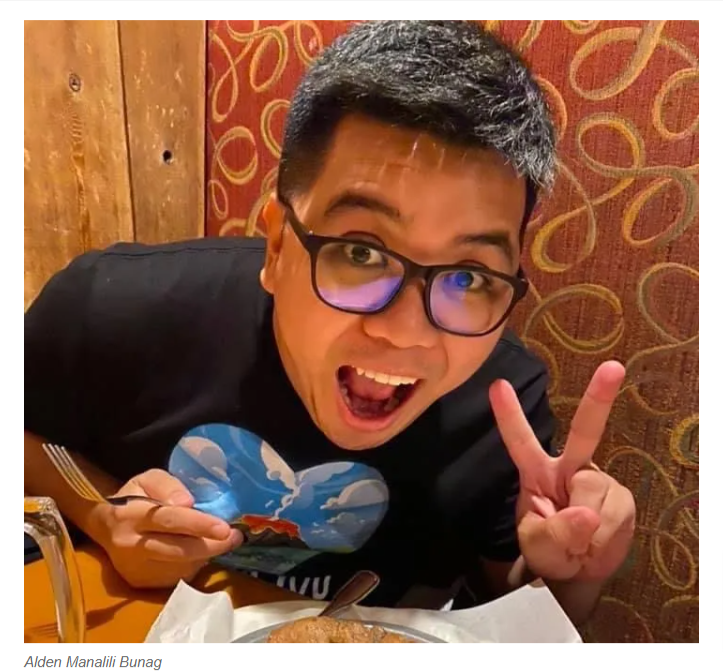
He also brazingly recorded the sexual encounters and shared them with another teacher employed in Philadelphia, Pennsylvania, who was also charged with distributing child pornography.
Bunag was also active on the internet and Twitter. He was a self-described “Socialist” and member of the LGBT community who often tweeted his political and sexual views openly online before he raped the 13 year old boy.
Someone has since deleted all his social media accounts after his arrest, but some people took these screen shots before they were taken down.

In researching Bunag’s Twiiter account, it appears that he was active in defending his right to talk to his students about sex, and when he was accused of grooming children, he adamantly denied doing so.
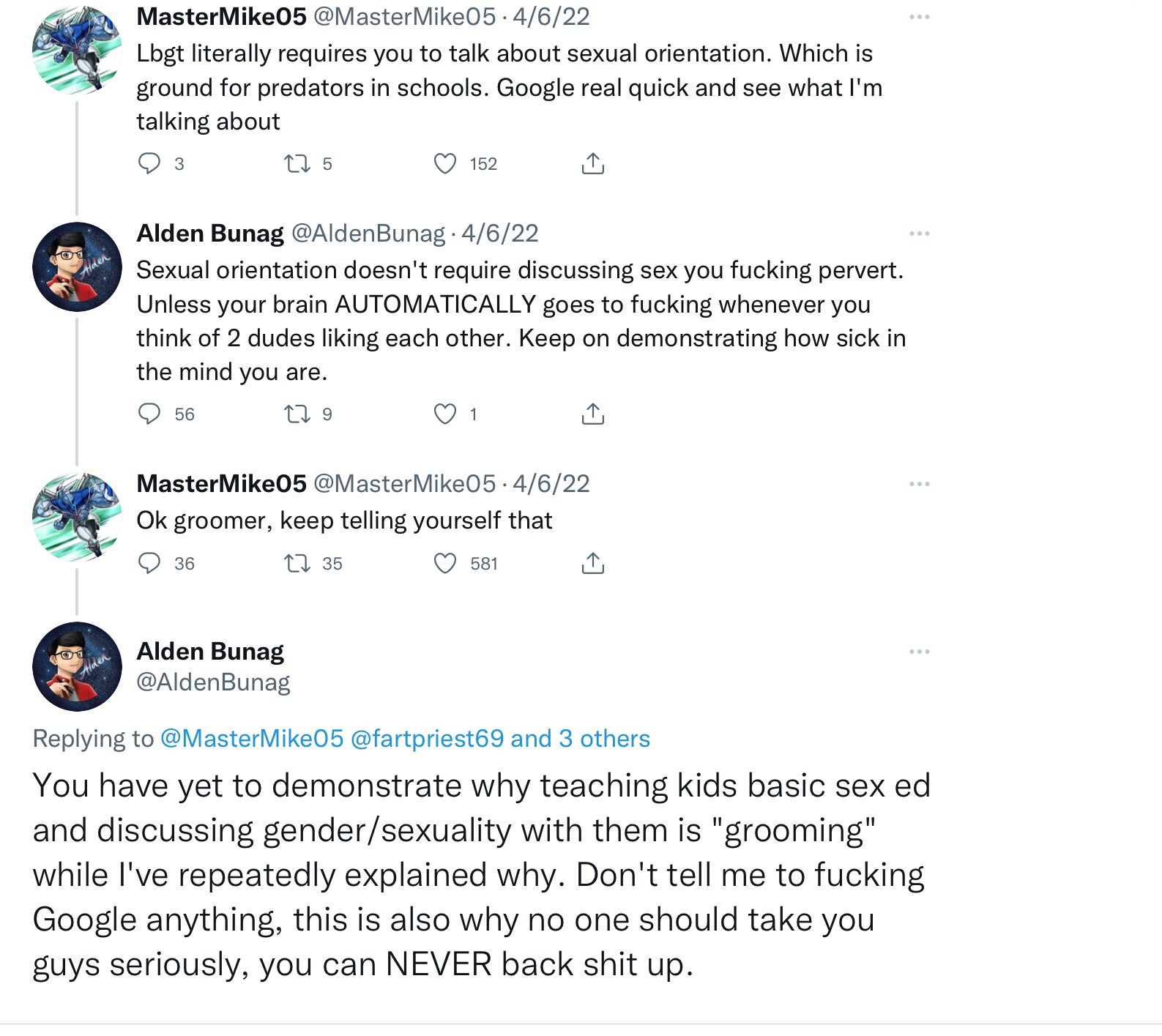
In June 2022, a former North Carolina band teacher, Peter Frank, was found guilty of sex crimes involving a student at the Roland-Grise Middle School, and was sentenced to at least 50 years in prison.

Frank was found guilty on two counts of first-degree sexual offense, four counts of statutory sex offense with a person who is 13, 14, or 15, one count of sexual activity with a student, seven counts of indecent liberties with a child, and three counts of indecent liberties with a student, WECT-TV reported.
According to Star News, “Frank was arrested in 2020. He was one of three teachers arrested over a two-year period for allegedly committing sex crimes with his students — Michael Kelly was taken into custody in February 2018 and later pleaded guilty to 59 charges for sex crimes, and Nicholas Oates was arrested in July 2018 but died before heading to trial.”
In February 2022, a former Louisiana teacher who pleaded guilty to tainting cupcakes with her ex-husband’s bodily fluids and feeding them to school children was sentenced Friday to 41 years in prison, according to US News.
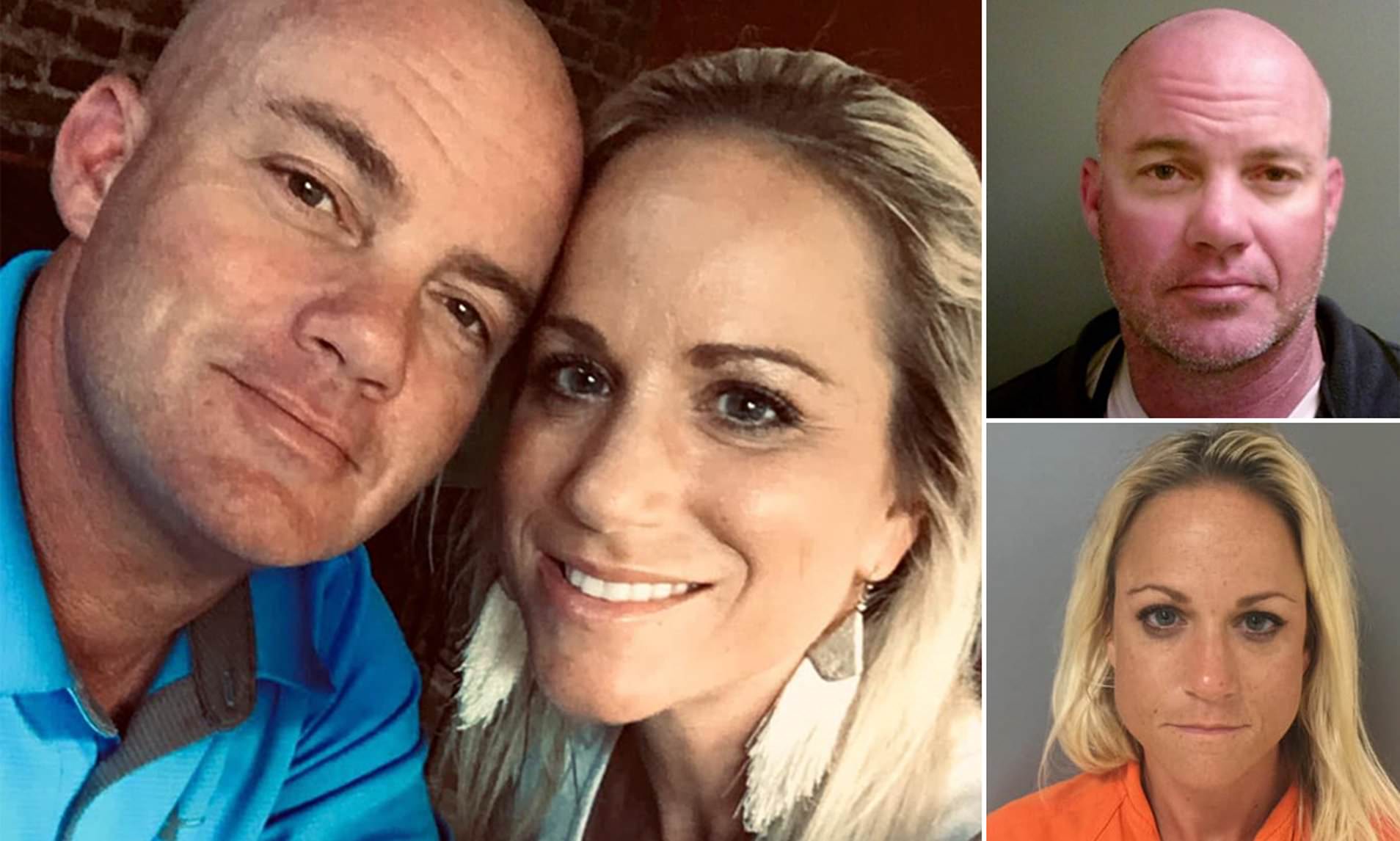
Authorities said Cynthia Perkins committed the acts with her ex, Dennis Perkins, a former Livingston Parish sheriff’s lieutenant.
US News reported that Perkins issued a lengthy apology before the sentencing.
“I would also like to apologize to my three children. I haven’t spoken to them in three years. I love them and I miss them, and I’m sorry,” Perkins said.
But one of her children, born during her first marriage, described her in a letter to the court as a “horrible” and “manipulative” mother.
“My life is so much better without you,” the letter read.
I could go on and on with example after example of school employees committing sexual crimes. If you choose to research this more on your own, you will find hundreds, if not, thousands of news reports verifying the facts I state in this article.
SCHOOL EMPLOYEE SEXUAL CRIME STATISTICS
In 2002, the U.S. Department of Justice (USDOJ) issued a report called, “Professional Perpetrators: Sex Offenders Who Use Their Employment To Target and Sexually Abuse the Children With Whom They Work.” The USDOJ said;
“Any organization or institution, whether statutory or voluntary, that cares for children is vulnerable to infiltration by professionals who intend to abuse the children, including child care institutions, foster care, churches, schools, and voluntary organizations. Faller (1988) found that the majority of offenders in an institutional setting were deliberately seeking situations in which they might abuse children.”
Section 5414 of the Elementary and Secondary Education Act of 1965, as amended by the No Child Left Behind Act of 2001, requires “a national study of sexual abuse in schools.” The results were published in a 2004 Department of Education (DOE) study that found nearly 10 percent of K-12 students have been victims of sexual misconduct by a school employee.
To show how grim the numbers are, the report said 422,000 California public-school students would be victims before graduation. That is just one state.
These teacher sexual predators and pedophiles are being protected by schools officials and their powerful unions who are attempting to cover up these facts by hiding files and evading investigations.
The DOE report stated:
In 2003, the Dallas Morning News (Jennings and Tharp, May 2003) and the other in the Seattle Times (Willmsen and O’Hagan, December 2003), examined educator sexual misconduct in their respective states.
Jennings and Tharp focused on 606 cases of educator sexual misconduct from Texas State Board of Educator Certification records and Willmsen and O’Hagan targeted abuse by coaches. In both instances, reporters commented on the difficulty of obtaining information on educator sexual misconduct.
O’Hagan and Willmsen (Dec. 14, 2003) write:
When the Seattle Times asked the Bellevue School District for information about teachers and coaches accused of sexual misconduct, school officials and the state’s most powerful union teamed up behind the scenes to try to hide the files. Bellevue school officials even let teachers purge their own records at union-organized “file parties” to prevent disclosure.”
A 2018 study by the Education Department found that reports of sexual assaults at elementary, middle, and high schools increased sharply by 55 percent, from approximately 9,600 in 2015-2016 to about 15,000 in 2017-2018.

The report defines sexual assault as involving threatened rape, fondling, indecent liberties, or child molestation. Both male and female students can be victims of sexual assault.
Parents need to understand that this increase is strongly associated with public school employees sexually assaulting children.
This news is tragic because it’s been documented that victims of child sexual abuse are at a much higher risk of developing long-term mental health issues and physical disorders such as depression, guilt, anxiety, and posttraumatic stress disorder (PTSD). Many researchers claim that child sexual abuse leads to more attempts at self-harm, drug abuse, suicides and can change a person forever.
According to a recent study published in JAMA Network Open: Pediatrics, childhood abuse, whether sexual, emotional, or physical in nature, is significantly associated with higher rates of suicide attempts. Researchers found that sexual abuse was associated with a 4-fold increased odds for suicide plans (OR, 4.12; 95% CI, 2.44-6.95) and a 3.5-fold increased odds for suicide attempts (odds ratio (OR) 3.42; 95% CI, 2.90-4.00).
Our schools are supposed to keep children safe from sexual assaults, abuse and other acts of violence. Unfortunately, they have become breeding grounds for child abusers to prey upon our kids, and they often go unpunished and simply move from one school to the next so they can repeat their sickening behaviors.
Any school, institution, or person that has allowed children to be harmed by sexual predators deserves to be taken to task for it.
Moe is the founder of GnosticWarrior.com. He is a father, husband, author, martial arts black belt, and an expert in Gnosticism, the occult, and esotericism.




























